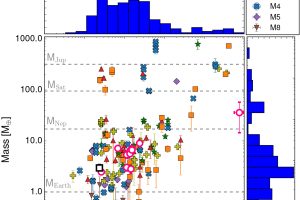A super-Earth for the star GJ 740. The study: “A super-Earth on a close-in orbit around the M1V star GJ 740. A HADES and CARMENES collaboration” of B. Toledo-Padrón (IAC) recently appeared on Astronomy & Astrophysics

In the last years, stars of spectral class M (which are stars with effective temperatures between 2400 and 3700 K and masses between 0.08 and 0.45 solar masses) have been extensively observed for the search of exoplanets. This both because they are the most abundant class of stars in the Galaxy, and because the low star/planet mass ratio, compared to stars of other spectral classes, facilitates the detection of exoplanets. For instance, the Kepler mission (which was one of the most prolific mission in this field, detecting exoplanets with the transit method, which consists in the detection of small and periodic occultations of the star by their planets as they orbit around their stars) discovered 156 planets around M stars. From these data, astronomers estimated that on average M stars host 2.5 planets with orbital period <200 days.
M stars are also the ideal targets for the search of exoplanets with the method of radial velocity. This method consists in detecting the small oscillations of the stars in the radial direction because of the gravitational attraction and the orbit of their planets, by means of spectroscopic observations. Since the first discovery of an exoplanet around a M star by radial velocity, occurred in 1998, to date 116 exoplanets around M stars were discovered with this technique. The major difficulty intrinsic in this method is due to the intense magnetic activity of these stars, which may produce spectroscopic signals that can mimic and confuse those due to exoplanets.
The team led by the astronomer B. Toledo-Padrón, of the Instituto de Astrofísica de Canarias, recently reported the discovery of a super-Earth with an orbital period of 2.4 days and a mass upper limit of 2.96 Earth masses, orbiting around GJ 740, a M1V star at a distance of about 37 light years from Earth. The study is part of the project HADES (HArps-n red Dwarf Exoplanet Survey), which is based on observations taken with HARPS-N, mounted on the Telescopio Nazionale Galileo (TNG) on the Roque de Los Muchachos Observatory in La Palma. The authors of the study have also combined the HARPS-N observations with data acquired with the spectrographs CARMENES at the Calar Alto Observatory and HARPS at the La Silla Observatory of the European Southern Observatory. These data also suggest the presence of a second planet with an orbital period of 9 years, but its radial velocity signal may be due to the stellar cycle instead. The astronomer J. Maldonado, G. Micela e L. Affer of INAF-Osservatorio Astronomico di Palermo are co-authors of this study, which recently appeared on the journal Astronomy & Astrophysics.
The figure (click here to visualize the entire image) shows a mass vs. period diagram of the exoplanets in the NASA Exoplanets Archive. The different colors mark the spectral types of the parent star. GJ 740 b is marked with a black square, while the other planets discovered in the framework of the HADES program are marked with empty dots. The horizontal lines mark the masses of Jupiter, Saturn, Neptune, and Earth.
